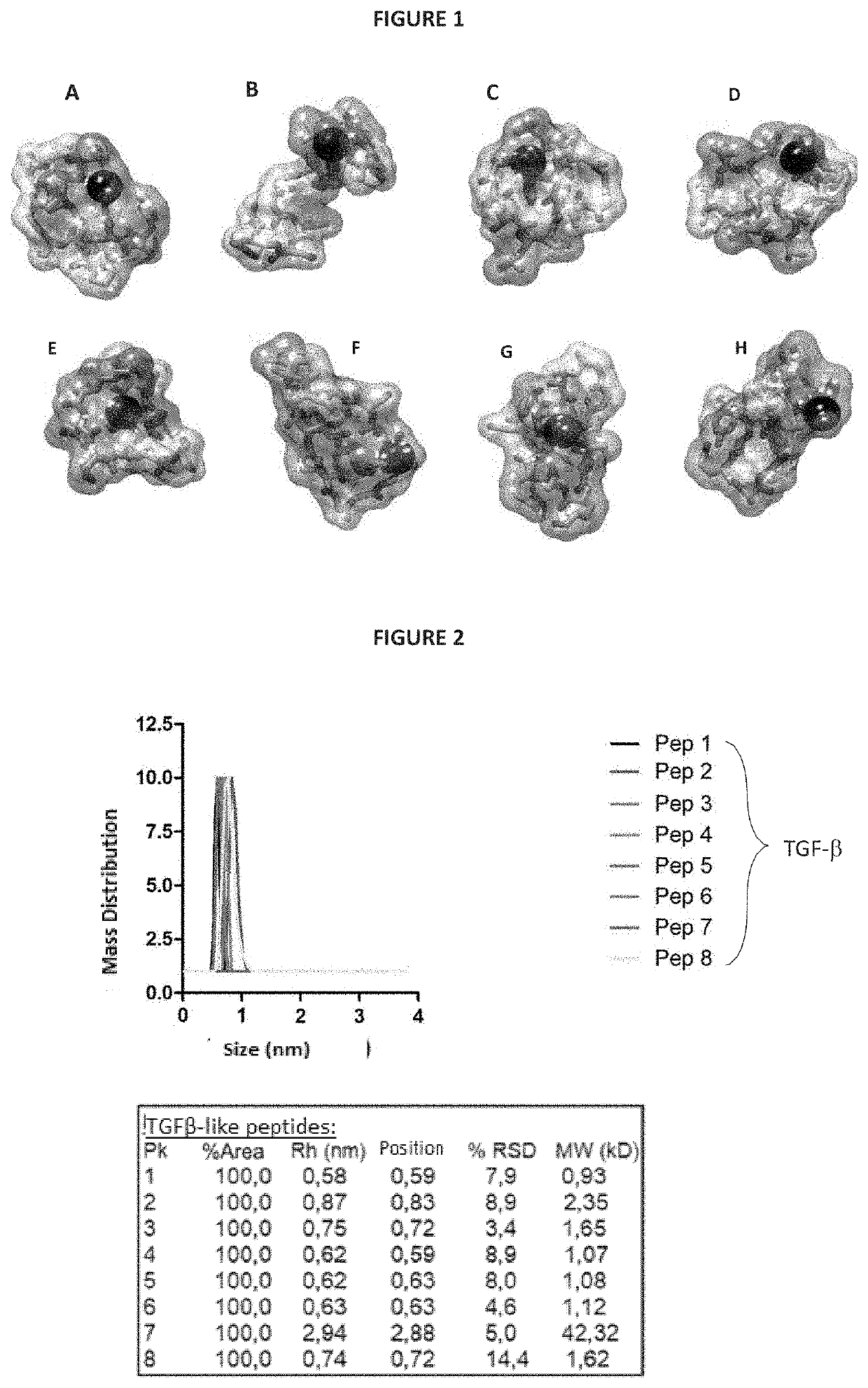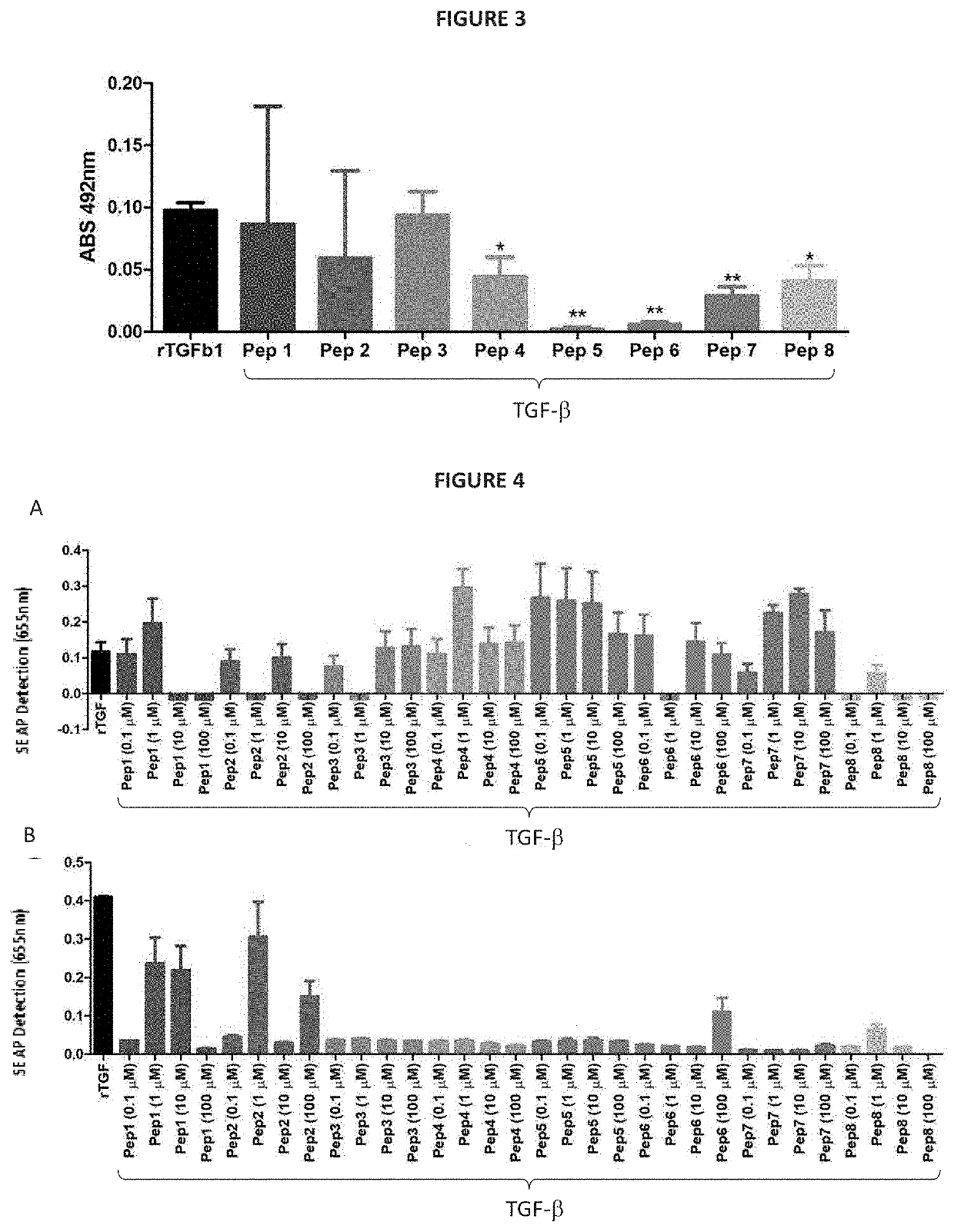Combination of synthetic peptides with affinity to the tgf-ß receptor and with affinity to the il-10 receptor, pharmaceutical composition and their use as immunomodulators in the treatment of autoimmune, inflammatory or allergic diseases
- Summary
- Abstract
- Description
- Claims
- Application Information
AI Technical Summary
Benefits of technology
Problems solved by technology
Method used
Image
Examples
example 1
on of Anti-TGF-β1 Antibody on the Cell Surface of the A549 Line
[0128]To investigate whether the synthesized peptides could bind to cell receptors, an ELISA assay was performed on cells of the A549 line using commercial anti-TGF-β1 antibody.
[0129]All eight tested peptides were able to recognize and bind to receptors on the cell surface of A549 cells. The synthesized peptides Pep 1-TGF-β1, Pep 2-TGF-β1 and Pep 3-TGF-β1, bound to cell receptors, were recognized by the anti-TGF-β1 antibody, in the same way that the antibody recognized the TGF-β1 recombinant molecule. However, the peptides Pep 4-TGF-β1, Pep 5-TGF-β1, Pep 6-TGF-β1, Pep 7-TGF-β1 and Pep 8-TGF-β1, also bound to cell receptors, were recognized as statistically different by the antibody, compared to recombinant TGF-β1 [Pep 4 (P<0.05), Pep 5 (P<0.005), Pep 6 (P<0.005), Pep 7 (P<0.005) or Pep 8 (P<0.00<0.05)] (FIG. 3).
example 2
f TGF-β1 Mimetic Peptides to Activate the SMAD-Dependent Pathway
[0130]To investigate the ability of peptides to bind TFGβRII and activate the SMAD-dependent pathway, HEK-blue-TGFβ cells were treated with peptides at 0.1 μM, 1 μM, 10 μM and 100 μM for 12 hours (FIG. 4A), 24 hours (FIG. 4B) and 48 hours (FIG. 4C). After 12 hours of stimulation (FIG. 4A), all peptides were able to bind to the receptor. Particularly for some peptides, and at specific concentrations, we obtained statistically significant results such as: Pep 1 (0.1 μM and 1 μM), Pep 2 (0.1 μM and 10 μM), Pep 3 (0.1 μM, 10 μM and 100 μM), Pep 4 (0.1 μM, 1 μM; 10 μM and 100 μM) Pep 5 (0.1 μM, 1 μM, 10 μM and 100 μM), Pep 6 (0.1 μM, 10 μM and 100 μM) and Pep 7 ((0.1 μM: 1 μM; 10 μM and 100 μM) and Pep 8 (1 μM). However, when cells were analyzed after 24 hours (FIG. 4B), activation was maintained, with significant result, by Pep 1 (1 μM and 10 μM), Pep 2 (1 μM and 100 μM), Pep 6 (100 μM) and Pep 8 (1 μM). After 48 hours (FIG...
example 3
f TGF-β1 Mimetic Peptides in the NFKB Pathway
[0132]Two different cell treatments were performed using Jurkat cells to analyze NFkB expression after 12, 24 and 48 hours. In the first test, Jurkat cells were treated only with peptides (no pathway activating molecule) at different concentrations to analyze the ability of each peptide to induce NFkB expression (Figure not shown). None of the tested concentrations induced any type of pathway activation. According to this result, cells were pretreated with peptides for 1 hour followed by TNF-α stimulation (FIG. 5A, B, C) and vice versa (pretreated with TNF-α for 1 hour followed by addition of the peptides) (FIG. 5D, E, F).
[0133]Peptide pretreatment was not able to reduce NFKB activation after 12 hours of treatment (FIG. 5A); however, when cells were analyzed after 24 hours (FIG. 5B), the peptides were able to decrease the activation of the NFKB pathway compared to the TNF-α control, particularly for some peptides and at specific concentra...
PUM
| Property | Measurement | Unit |
|---|---|---|
| Fraction | aaaaa | aaaaa |
| Composition | aaaaa | aaaaa |
| Affinity | aaaaa | aaaaa |
Abstract
Description
Claims
Application Information
 Login to View More
Login to View More - R&D
- Intellectual Property
- Life Sciences
- Materials
- Tech Scout
- Unparalleled Data Quality
- Higher Quality Content
- 60% Fewer Hallucinations
Browse by: Latest US Patents, China's latest patents, Technical Efficacy Thesaurus, Application Domain, Technology Topic, Popular Technical Reports.
© 2025 PatSnap. All rights reserved.Legal|Privacy policy|Modern Slavery Act Transparency Statement|Sitemap|About US| Contact US: help@patsnap.com



